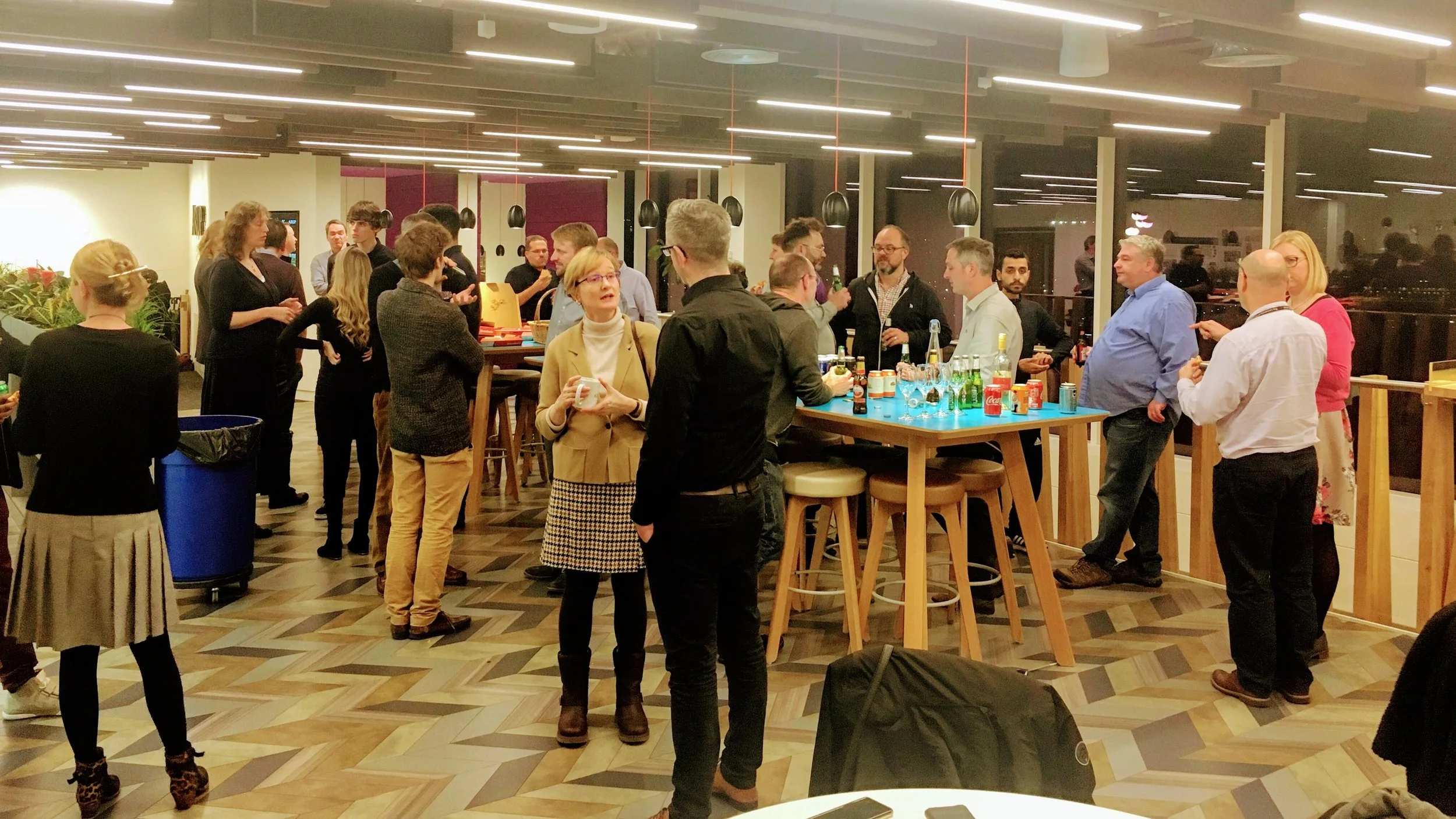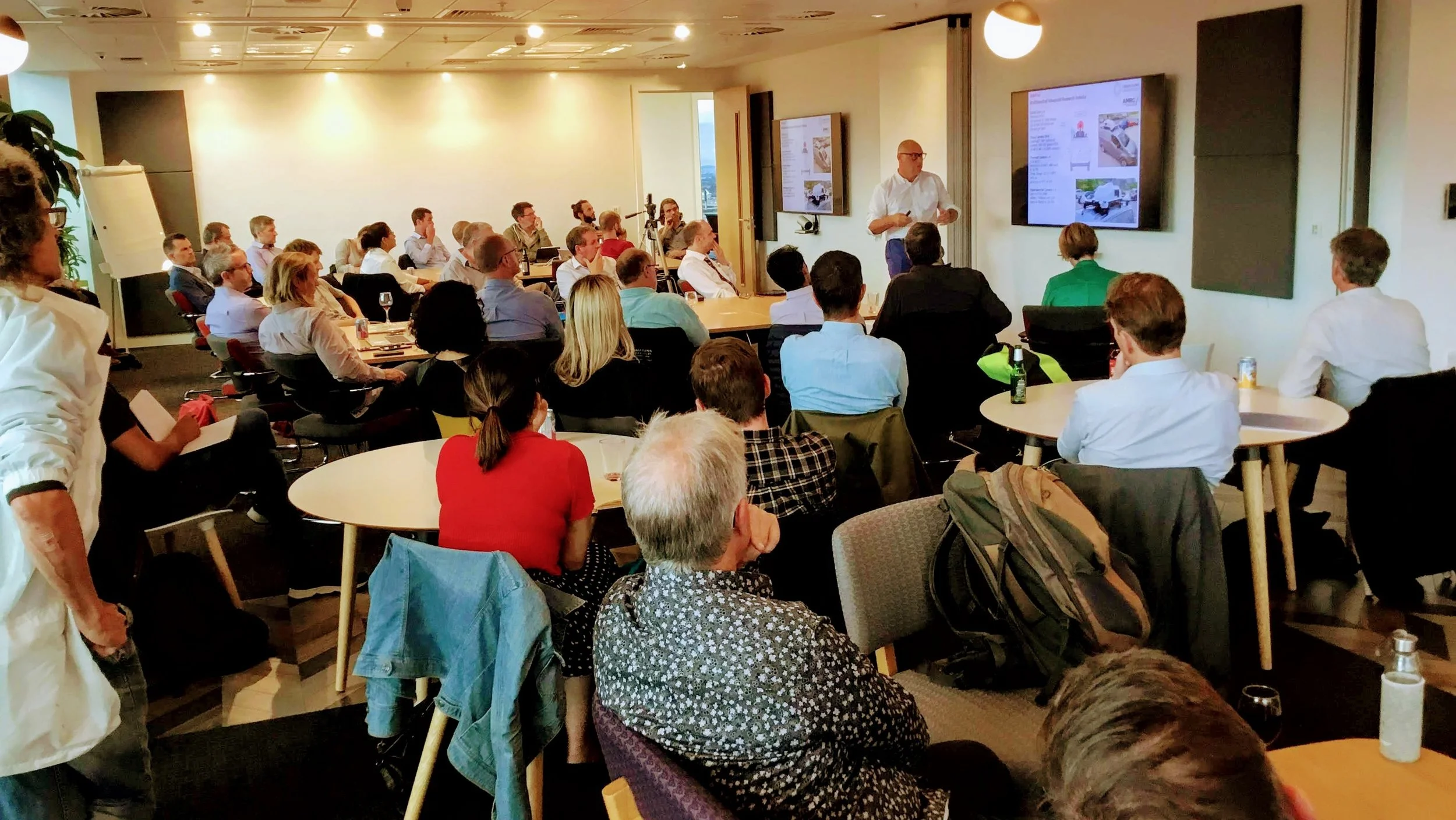Notes from Meetup #12: IoT for Citizens
What a lovely meetup we had on Monday!
Despite the dark evenings, and miserable weather we had a full turnout of people, many of whom were new participants, who witnessed some great talks around IoT and engagement with people in the city.
Several people commented to me on how much they enjoyed the format of the evening as well as the speakers, and it really felt like the format was back to what Matt and I originally envisaged when we designed the SmartSheffield meetup over two years(!!) ago now: a relaxed arrival, introductions from everyone present, four good and concise talks followed by some news, and then food, drinks and good chats for at least an hour afterwards.
This time it really worked, and we think the biggest difference (apart from the speakers sticking to time, which was most excellent and appreciated!) is that we didn’t allow any Q&A. Usually we take a few questions and tell speakers that there will be 5 minutes Q&A at the end of the talks, but in practice this means that over-long talks then go on for even longer. Q&As are valuable of course, but ultimately we think conversation is more valuable, and so we asked people to talk to the speakers once we break for food - that way they can ask more in depth questions, and there will be more time to get into deeper conversations as there is a full hour to do so - or even slightly more if we let it carry on past 9pm, which as people were still having such a good time and the conversations were so fruitful, we did this time!
Anyway, this is how we intend to continue next year - we hope everyone is on board!
Here are the night’s talks:
Joe Dreimann from the David and Jane Richards Family Foundation
Teaching IoT in Schools
By day Joe is the User Experience Lead at big data company WANdisco, but by night (well by evenings and the odd weekend), he guides the efforts of the educational foundation set up by WANdisco’s founder David Richards and his wife Jane.
The foundation’s mission is to bring a new kind of computing education to secondary school pupils - one which focuses on the technologies and skills that are still emerging in the industry, rather than those that are well established. In in other words the capabilities that are going to be relevant, rather than “legacy skills”.
The foundation is trialling their new curriculum with Tapton School this school year, before rolling out to other local schools in the future, and, as Joe explains, the first term which is coming to an end covered data science, the next term in the new year is looking at the Internet of Things, and how to build infrastructure and applications.
The foundation is keen for more employers to get involved with setting the curriculum and defining project work for the pupils to undertake, and he is especially interested in input from the SmartSheffield community to make the content ‘more real’; i.e. closer to the work and thinking of real practitioners in the IoT space. What should they bring to the classroom, or what should they take the classroom to see?
Please watch Joe’s presentation to get a better idea of what they are doing, and get in touch with him at this address: joe@djrff.org
Damian Bemben, Megan Naylor and Kyle McLean from the University of Sheffield’s Engineering Leadership Academy
Explaining the Urban Flows Observatory to the Public
Damian, Megan and Kyle are all members of the University of Sheffield’s Engineering Leadership Academy (SELA), and are currently leading a project with the Urban Flows Observatory to increase their outreach activities and get the general public engaged in what the Observatory is doing.
As regulars will know, the Urban Flows Observatory is project run by the Universities of Sheffield, Newcastle and Bristol to attempt to measure the city’s “energy metabolism” using a range of sensors some of which are incorporated into a mobile platform - a van called Moebius.
You can see more about the Observatory here and here (including the famous meetup nearly 2 years ago where Martin Mayfield sent us the project outline presentation but then couldn’t make the meetup, so we collectively tried to interpret what it was al about just from his slides! I’ve often thought we should do that more often :-D)
The Observatory has an essential mandate to engage with stakeholders and the general public, “so that they understand [the Observatory’s] purpose, have confidence in the techniques employed and therefore have confidence in the data produced, which will provide an evidence base for future policy-making.”
For their part, the SELA students are particularly looking to engage with school children, and through them the parents as well. To do this they have distilled their brief down to three specific objectives and two modes of engagement, as follows:
Promote the observatory’s activites
Raise awareness of how data can enable decisions
Incorporate the internet of things as an enabling area of technology
The two modes of engagement are targeted at different groups of stakeholders, and will be:
A ‘roadshow’ that takes Moebius to schools and communities to introduce the observatory to them and show how it all works and what it’s used for.
A web / mobile app that shows the user environmental readings at various locations, triggered by QR codes around the city.
The team are seeking input and advice from the SmartSheffield community as these plans shape up, especially around using IoT for public engagement.
Content the team at this email address: SELA@Sheffield.ac.uk
Zak Ahmed from Aalfy
Sheffield as a Playable City, and the AR’ City Festival
Zak runs a social enterprise called Aalfy, based in a former post office at 108 The Moor, and which provides an alternative path into education for young people for whom the system, or circumstances, just haven’t worked. They have been responsible for a number of great initiatives over the years, including Learn Create Sell which shows people how to make new things with laser cutters, and provides them with a route to market for their creations.
Zak came to our May meetup earlier this year and, inspired by my talk on Play, Creativity and Co-creation in the smart city, set out to build a new programme called AR’ City around the playable city concept, “using play as a way of connecting with citizens, [it] aims to add memorable experiences in our everyday moments on the high street.”.
This resulted in a successful six week engagement in partnership with the Architecture department at the University of Sheffield, in which 48 young people developed 16 playable city concepts and worked with technologists to prototype three of them.
Zak is looking to take this experience further, and is currently planning a two week festival for next September: AR’ City Sheffield, in which more of the concepts are converted into real playable experiences in the city centre.
Zak is looking for collaborators, sponsors and technical experts who can work with the cohorts of young people to help them realise their ideas (or tell them when things are too expensive or straight impossible!).
Please watch Zak’s terrific story and get in touch with him at hello@aalfy.org
Tracey Johnson from Barnsley Digital Media Centre
Barnsley’s journey from Coal to Code
Tracey is the director of Barnsley’s Digital Media Centre, and has been at the heart of developing the digital tech sector in the town. She tells the story of this activity and how the pace of change has picked up over the last three years, especially with their involvement in the European URBACT: Tech Towns programme, which looked at what an ecosystem needs in order for the tech economy to thrive, and how that has now led to a raft of new initiatives, including:
The new Barnsley Digital Campus.
IoT Tribe North accelerator (which is now open for the second cohort).
Leading the Digital Manufacturing agenda.
“Skunkworks” internal incubator at Barnsley Council.
Barnsley.io maker group.
The Connected Lab.
Beyond this immediate action plan, they know they also need to build their skills pipelines, provide more spaces for experimentation and incubation, and develop more cross-sectoral collaborations. And they know physical infrastructure is not enough, but that human capital and support is crucial. As Tracey sees it, it is about “bringing together digital people, learning and business across a connected campus of places and spaces both online and offline to deliver more and better jobs and businesses.”
If anyone would like to get involved in any of Barnsley’s programmes, get in touch with Tracey at: dmc@barnsley.gov.uk
Chris Dymond from Unfolding
SmartSheffield News
I finished off the talkie bit of the evening, as always, by drawing attention to relevant smart city-esque things I’ve become aware of recently:
The Kollider technology hub at Castle House is progressing, with the National Video Museum opening last weekend, and other floors scheduled to come on stream early in the new year. They are building 9 ‘centres of excellence’ in different technology and market verticals, including one called “Intelligent Environments”, which covers smart city and IoT applications.
governance.SHF is the latest dotSHF domain to spark into life, along with people.SHF (which is planning a social care and universal credit summit in the Spring) and economy.SHF which also meets regularly. dotSHF is the city’s digital coalition, and brings together stakeholders and interested parties across seven city domains. The governance domain was initiated with a workshop on public sector challenges, facilitated by Future Gov, about which you can read here.
It’s Our City is a non-political network of Sheffield residents who are working together to affect change in the city, including the desire to make the city more democratic in its decision making. I highlight them here as an opportunity to explore how technology and data might fit into this agenda and in the hope there could be common cause.
All twenty of the refurbished Gas Destructor Lamps have now been restored to their original settings around Sheffield. They are a real tangible piece of Sheffield’s history of technological urban innovation.
Breastfeeding in Sheffield is aiming to make the city the most breastfeeding friendly city in the country for new mothers, and have encouraged the council to open a dedicated breastfeeding room in the Town Hall, and other rooms around the city. Is there an opportunity to provide applications both to help people find them, and let others know if they are good to use?
The Sheffield Park Project is another grass-roots project to build an information resource in the city, this time around Sheffield’s green spaces (of which there are 850 under management by the city council!). Their app is nearly ready for testing, and you can register to get a link to it if you would like to help them get it to launch.
As I mentioned in September, ShopAppy is trying to make it more convenient for people to shop locally by providing a simple mobile interface and aggregated fulfilment and collection. It is also based in Yorkshire, and is currently active in some small towns, including Barnsley, but it would be interesting to see if it can gain a foothold in Sheffield perhaps by covering individual neighbourhoods first.
Sheffield Things Network is now up to 14 gateways in Sheffield (alright, four of them are in Chesterfield ;) and 31 contributors. If you would like to get involved in building a community-owned LoRaWAN network and building applications for it, please join the community!
And that was it!
Have a lovey Christmas everyone, and we look forward to more meetups in the new year!








